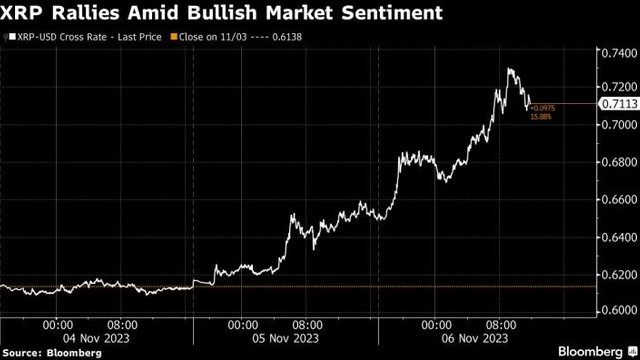

Decentralized finance is making a surprise comeback, as the latest cryptocurrency rally spreads to the sector that has struggled with growth since last year’s high-profile collapses and a jump in interest rates in traditional markets.
Interest rates to borrow stablecoins meant to track the US dollar, such as USDC and Tether, have surged to more than 10% on Aave, the largest lender among DeFi projects that allow peer-to-peer cryptocurrency transactions without middlemen. A higher interest rate means that more traders are willing to pay up to borrow the stablecoins, a sign that they are levering up their crypto bets. For months, the rates had been depressed as DeFi’s once lofty returns were nowhere to be found amid decades-high yields in the traditional bond market.
The surge in lending demand on DeFi has coincided with the reemergence of positive funding rates in the perpetual futures market, one of the most popular derivatives contracts in crypto. Data from tracker Coinglass show that the open interest-weighted funding rate turned positive this past weekend for tokens including Ripple’s XRP, which means that speculators betting on a price rally are willing to pay those expecting declines to keep their bullish positions open. XRP is up by 12% on Monday, while other major alt-coins such as Dogecoin are also trading higher.
“There have been a number of ‘wealth effects’ that usually cause lending demand to go up when there’s a huge run up in a particular token. There’s also short-side lending demand from large holders,” said Tarun Chitra, co-founder of crypto risk modeling platform Gauntlet. “Leverage in DeFi is reflexive — when prices go up, there’s naturally an increase in leverage demand for people who want to make longer-term speculative bets on the market moving in a particular direction.”
Bitcoin rallied about 28% in October, the biggest monthly increase since January, as expectations grew that the US Securities and Exchange Commission soon will approve exchange-traded funds that invest directly in the original cryptocurrency after more than a decade of deliberations. Since then, Bitcoin’s rally has spread to smaller tokens such as Solana, which was one of the best performing cryptocurrencies this year despite its close link to FTX co-founder Sam Bankman-Fried, who was convicted of fraud last week almost a year after the collapse of his crypto empire.
The rising borrowing rates in DeFi and funding rates in the perpetual futures market also have created arbitrage opportunities for traders to profit from the differences between the two.
“Aave and perp rates generally should be somewhat correlated, as you can arbitrage between the two,” said Spencer Hallarn, a derivatives trader at crypto investment firm GSR. “Overall it speaks to the demand to own crypto” in the derivatives market.
The blowups last year of a number of centralized lenders such as BlockFi also left DeFi lenders as some of the only places available for leveraged trades, according to Chitra. Darius Sit, founder and chief investment officer at Singapore-based crypto investment firm QCP, noted that the lending demand via over-the-counter desks is not elevated.
“Lending and leverage is definitely coming back,” said Noelle Acheson, author of the Crypto Is Macro Now newsletter. “This is a natural consequence of not just a pickup in investor interest, but also a pickup in volatility — volatility encourages leverage and therefor, demand for lending.”
